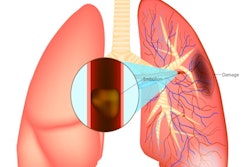
AUSTIN, TX - An AI-based workflow that involves CT technologists can significantly improve management of patients with an incidental pulmonary embolism (PE), according to a June 15 presentation at the Society for Imaging Informatics in Medicine (SIIM).
After implementing a new triage workflow for routine outpatient contrast-enhanced chest CT exam that involved CT techs in the process, researchers from UT Southwestern Medical Center in Dallas found that the change led to significant reductions in the average time for patients to present to the emergency department (ED) or to receive anticoagulant medication.
"Implementing a clinical framework [integrating AI results] allows radiologists to quickly act on a detection of an [incidental pulmonary embolism] and prevent delays in care," said presenter Ali Tejani, MD, a postdoctoral research fellow. "I'd like to emphasize that this is a team effort. We should engage additional medical personnel -- in this case, our frontline clinical personnel, our CT technologists -- for timely intervention for emergent or urgent findings."
Clinical impact
Although AI algorithms can show great statistical performance for metrics such as area under the curve or sensitivity, those results don't necessarily reflect the clinical impact of these models, Tejani noted. Better metrics could include time to present to the ED, time to treatment, and hospital readmission rate.
"There is a need to start thinking about the ultimate clinical impact [of AI] on patient care," he said.
In their study, the researchers sought to implement an AI-based workflow that involves CT technologists with the goal of decreasing time to ED presentation or medication prescription for incidental PEs detected on outpatient chest CT studies.
Previously at their institution, patients receiving outpatient chest CT exams would leave the imaging center after their study was completed. If the AI algorithm subsequently deemed an exam to be positive for PE, the radiology worklist was adjusted to prioritize the case for radiologist review. Upon confirmation of the incidental PE, the ordering provider was then contacted and efforts were made to contact the patient to discuss a clinical action plan.
"[There] isn't always a successful contact [with the patient]," Nejani said.
A new workflow
In the new workflow, patients receiving an outpatient chest CT exam are escorted to a holding room after the study to wait until the AI algorithm analyzes the exam. If the software detects a suspected PE, the CT technologist is notified and calls the radiologist for confirmation on the result.
If the finding of a new, acute incidental PE is confirmed, the radiologist then calls the ordering provider to discuss the results and also updates the technologist. The radiologist and technologist then share the findings and recommendations for a clinical plan of action with the patient. Based on their decision, the patient could then either be escorted directly to the ED after communication with the ED triage nurse, or receive a prescription for anticoagulant medication.
The new workflow produced a clinically meaningful benefit. The researchers retrospectively compared results before (January to May 2021) and after (June 2021 to February 2022) implementation in a total of 50 patients receiving an outpatient chest CT exam with an incidental PE. They found sharp reductions in the key metrics.
| Metrics before and after implementation of new AI workflow | ||
| Before implementation | After implementation | |
| Mean overall ED presentation time | 4.59 hours (median 2.73 hours) | 1.81 hours (median 1.81 hours) |
| Mean overall prescription retrieval time | 20.8 hours (median 15.4 hours) | 2.24 hours (median 2.17 hours |
| Mean ED presentation time (adjusted for gender, race, and exam priority) | 4.89 hours | 2.48 hours |
| Mean prescription retrieval time (adjusted for gender, race, and exam priority) | 18.3 hours | 1.99 hours |
Identification of emergent pathology during routine imaging is an opportunity to leverage AI technology to prevent adverse events from delays in care, according to the researchers.
"Implementing an AI-guided triage workflow engaging CT technologists enabled quicker time to ED transport and prescription retrieval," he said.
Tejani said that he hopes their results will serve as a call to action for identifying and monitoring clinical performance markers. This includes determining clinically relevant metrics for return-on-investment analysis and developing expert consensus to determine and prioritize clinically meaningful metrics, he said.
"We need collaboration with EHR vendors to streamline this process and... and so that we can scale to multiple use cases," Tejani said.





















